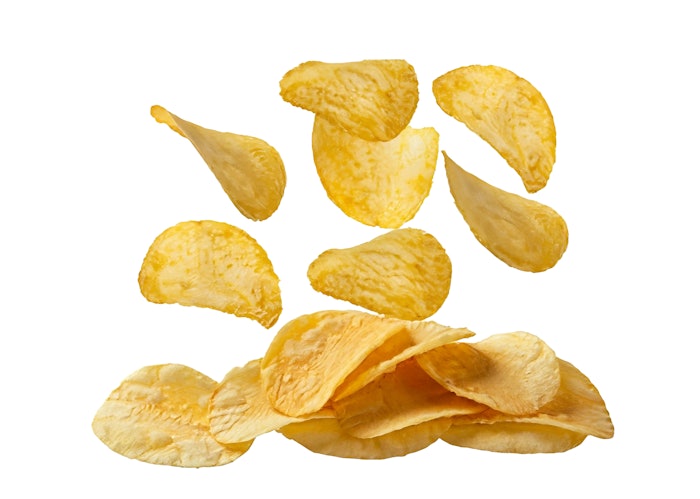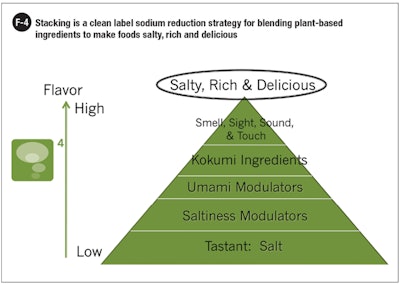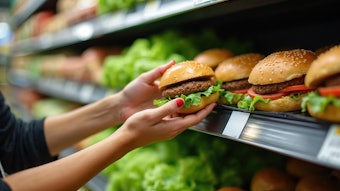
Saltiness
Low salt does not mean it has to be low flavor. We just need to learn a few things in saltiness neuroscience and apply them to create salty perception without salt. Flavor is a crossmodal integration of all five sensest—taste, smell, sight, sound and touch.1,2 The five basic tastes in the mouth are sweet, sour, bitter, salty and umami.
Taste bud is a cluster of about 100 taste cells. Each taste cell is dedicated to one taste so one taste, one cell. There are Type I, II and III cells. Type II cell are dedicated to either sweet, bitter or umami. Type III cells are for salty and sour detection.3 Thanks to rapid advances in neuroscience, all 40 taste receptors in the mouth have been found in the past 20 years. Umami taste (delicious) is detected by a primary receptor T1R1/T1R3 that responds to monosodium glutamate (MSG) in Type II taste cells. Saltiness is detected by a primary ion channel Epithelium Sodium Channel (ENaC) selective for sodium in Type III taste cells.4,5 Kokumi, which has not been proven a basic taste, mysteriously triggers Calcium Sensing Receptor (CaSR).
Aside from the primary ENaC, there is also a secondary pathway responding to both high level of sodium chloride (NaCl, table salt) and any level of potassium chloride (KCl). That’s why K is also salty but much less salty than Na. There is also a separate 2nd pathway for chloride and together making NaCl the saltiest substance in the world. Salty detection in the mouth leads to salty perception in the brain. The more we understand saltiness neuroscience, the more we know how to make thing salty without table salt.
Salty Modulators
Salt reduction is really about saltiness modulation. There are four strategies to make things saltier without adding more table salt (F-1). The first approach is to use natural salt substitutes. This includes sea salt and potassium salt by at least three suppliers.
Second approach is "saltier salt." Rather than solid crystals, salt was made into a porous microstructure with higher surface area for faster kinetic release from foods during eating. A little bit of salt tastes like a lot more salt, allowing up to 50% salt reduction. It tastes like salt because it is salt, but it works only for dry topical applications.6
The third approach is to leverage neuroscience: Perceptual Constancy and Crossmodal Correspondence. Perceptual constancy can be reduced to a practice called "layering." Layering or taste contrast such as high sodium-low sodium-high sodium layers in savory bakeries can be explored for up to 30% sodium reduction. Crossmodal correspondence can also be practiced by adding salty aroma (beef aroma for example) which enhances salty taste perception in the mouth via retronasal smell-taste interaction.7,8
The fourth and last approach is to use umami substances via another neuroscience finding called prior association. Salty and umami if perceived together earlier in life, umami taste perceived later in life will call up salty taste. This can be done with vegetable extracts naturally high in MSG, or by natural umami peptides found in nature.

Umami Modulators
The more we understand how umami works, the better we know how to use ingredient to increase umami directly and increase saltiness indirectly. Umami taste (delicious) is detected by a primary receptor T1R1/T1R3 that responds to MSG, it’s the taste of MSG. Umami is also detected by five different secondary pathways responding to other amino acids and peptides.
There are four approaches to make foods more umami (F-2). First approach is to use pure MSG. Nothing is wrong with MSG when used in moderation and below legal and safety limits. 1/3 MSG+2/3 salt delivered 25% sodium reduction. Label in EU is flavour enhancer (MSG) or flavour enhancer (E621).
Second approach is to use Natural MSG (F-2). It can be plant-based such as yeast extract or hydrolyzed vegetable proteins (HVP). It can also be animal-based including fish sauce. All of these are high in both naturally present MSG and nucleotides.
The third approach is vegetable extracts naturally high in umami such as tomato, mushroom, and blends thereof (F-2). Dosage is typically 0.5% as consumed.
The fourth and last approach is Natural PAM (F-2). PAM stands for Positive Allosteric Modulators. These are compounds that bind on the outside of the T1R1 VFT and close to MSG that binds inside of the T1R1 VFT, making MSG binding tighter thus 4X to 8X more potent. The trick is combining plant-based "basal umami" (that is, MSG) with animalbased "synergistic umami" (they are nucleotides IMP+GMP).9,10 Nucleotides, traditionally called MSG potentiators in food science, were recently proven to be MSG PAM in neuroscience.
Umami and salty peptides could also be PAM.11 Umami peptides were isolated from fermented Asian foods. Some of the "salty" peptides were Maillard-reacted peptides found in nature. They probably are not really "salty" but triggered umami secondary receptors and perceived as "salty" via prior association.

Kokumi Modulators
Kokumi is a Japanese sensory term refers to the sensation for overall thick, hearty, mouthwatering, balanced, and a long finish. Or "rich" in short. This is the mouthfeel in slow cooked stew or aged cheese. It had not been proven as a basic taste (F-3).
The most potent kokumi substance is a tripeptide Glutamyl-Valyl-Glycine (GVG) found naturally in garlic, onions and scallops. It is 10X more potent than glutathione, the first ever kokumi substance discovered in garlic, Glutamate-Cysteine-Glycine (GCG). GVG has a FEMA number 4709 with a beverage limit of 50ppm. Both GVG and GCG were reported to be PAM for CaSR, a secondary receptor for umami.
High kokumi sensation can be created by formulating with high-kokumi soy sauce or yeast extract, both dosed at less than 1% as consumed. Kokumi peptides not only increased kokumi but also enhanced salty and umami. In other words, salty umami kokumi come together in our perception via prior association and perhaps it could be considered "intra-modal" correspondence.
It’s interesting to note a new three-way chloride salt blends for sugar mouthfeel in sweet beverages, could be the same CaSR PAM for kokumi sensation in savory foods. It has a FEMA number of 5000, a gravies limit of 1,424ppm, and labeled as natural flavor.

Stacking
Taste detection is at the receptors in the mouth. Taste transduction in taste cells involves conversion of a junction potential to an electrical signal that goes through the taste nerves to the taste cortex in the brain. Smell Transduction goes from odors receptor binding in the nose to olfactory bulb and eventually to the olfactory cortex in the brain. These taste and smell signals are integrated to form "flavor" in orbitofrontal cortex.12 This is the neuroscience foundation why salty, umami and kokumi come together in our perception. Stacking is a clean label salt reduction strategy by blending salty, umami and kokumi ingredients together to make low sodium foods rich and delicious (F-4). We should use less salt and use umami and kokumi ingredients to make a little bit of salt taste like a lot more.

Summary
Clean label taste modulators is the field of changing and adjusting basic tastes with plant-based ingredients in reduced salt foods. There are four strategies to make foods saltier without adding more table salt which includes KCl and salty aroma. There are also four strategies to make foods umami such as vegetable extracts and natural PAM. All these ingredients increased umami directly and saltiness indirectly. Finally kokumi sensation can be created with kokumi peptides. Stacking is a clean label salt reduction strategy based on blending these three types of plant-based savory ingredients to make foods salty, rich and delicious.
References
1. Terry Acree. "Seeing" the Flavor of Foods. ACS news release April 11, 2013. ACS.org.2. Charles Spence. Eating with our ears. Flavour 4.3. 20153. Nomura et al 20204. Zufall and Munger. Chemosensory Transduction. 20165. Monell 2015, 2016.6. U IL Review 20227. Batenburg and van der Velden 20118. Smithsonian.com 20169. Umami. Mouritsen and Stybaek. 201510. Adam 201511. Ahmad and Daiziel 202012. Hayes and Baker, PSU 2022










